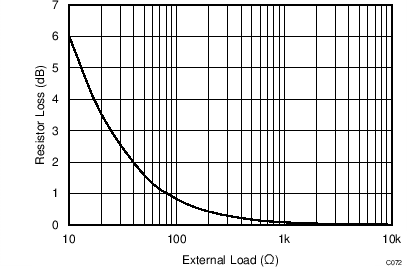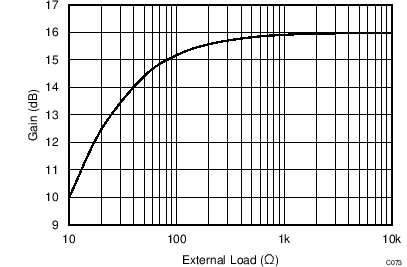ZHCSH86B December 2017 – February 2019 LMH5401-SP
PRODUCTION DATA.
- 1 特性
- 2 应用
- 3 说明
- 4 修订历史记录
- 5 说明 (续)
- 6 Pin Configuration and Functions
- 7 Specifications
-
8 Parameter Measurement Information
- 8.1 Output Reference Nodes and Gain Nomenclature
- 8.2 ATE Testing and DC Measurements
- 8.3 Frequency Response
- 8.4 S-Parameters
- 8.5 Frequency Response with Capacitive Load
- 8.6 Distortion
- 8.7 Noise Figure
- 8.8 Pulse Response, Slew Rate, and Overdrive Recovery
- 8.9 Power Down
- 8.10 VCM Frequency Response
- 8.11 Test Schematics
- 9 Detailed Description
-
10Application and Implementation
- 10.1 Application Information
- 10.2
Typical Application
- 10.2.1 Design Requirements
- 10.2.2 Detailed Design Procedure
- 10.2.3 Application Curves
- 10.3 Do's and Don'ts
- 11Power Supply Recommendations
- 12Layout
- 13器件和文档支持
- 14机械、封装和可订购信息
10.2.3 Application Curves
The LMH5401-SP has on-chip series output resistors to isolate the output of the amplifier. These resistors provide the LMH5401-SP extra phase margin in most applications. When the amplifier is used to drive a terminated transmission line or a controlled impedance filter, additional external resistance is required to match the transmission line of the filter. In these matched applications, there is a 6-dB loss of gain. When the LMH5401-SP is used to drive loads that are not back-terminated or matched, there is a loss in gain resulting from the on-chip resistors. Figure 76 shows that loss for different load conditions. In most cases the loads are between 50 Ω and 200 Ω, where the on-chip resistor losses are 1.6 dB and 0.42 dB, respectively. As an example, if the LMH5401-SP were to drive an ADC with a differential input impedance of 100 Ω without any matching components the signal loss would be 0.83 dB compared to 6 dB in a matched configuration. Of course, this is only feasible if the LMH5401-SP and the ADC are placed in close proximity (< 1/4 wavelength of the frequency of interest) so as to avoid standing waves from reflections due to the mismatch in impedances). Figure 77 shows the net gain realized by the amplifier for a large range of load resistances when the LMH5401-SP is configured for 16-dB gain.
 Figure 76. Gain Loss Resulting from On-Chip Output Resistors
Figure 76. Gain Loss Resulting from On-Chip Output Resistors  Figure 77. Net Gain versus Load Resistance
Figure 77. Net Gain versus Load Resistance